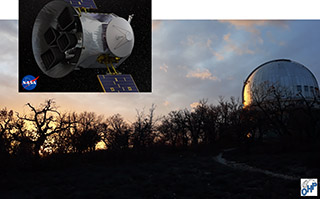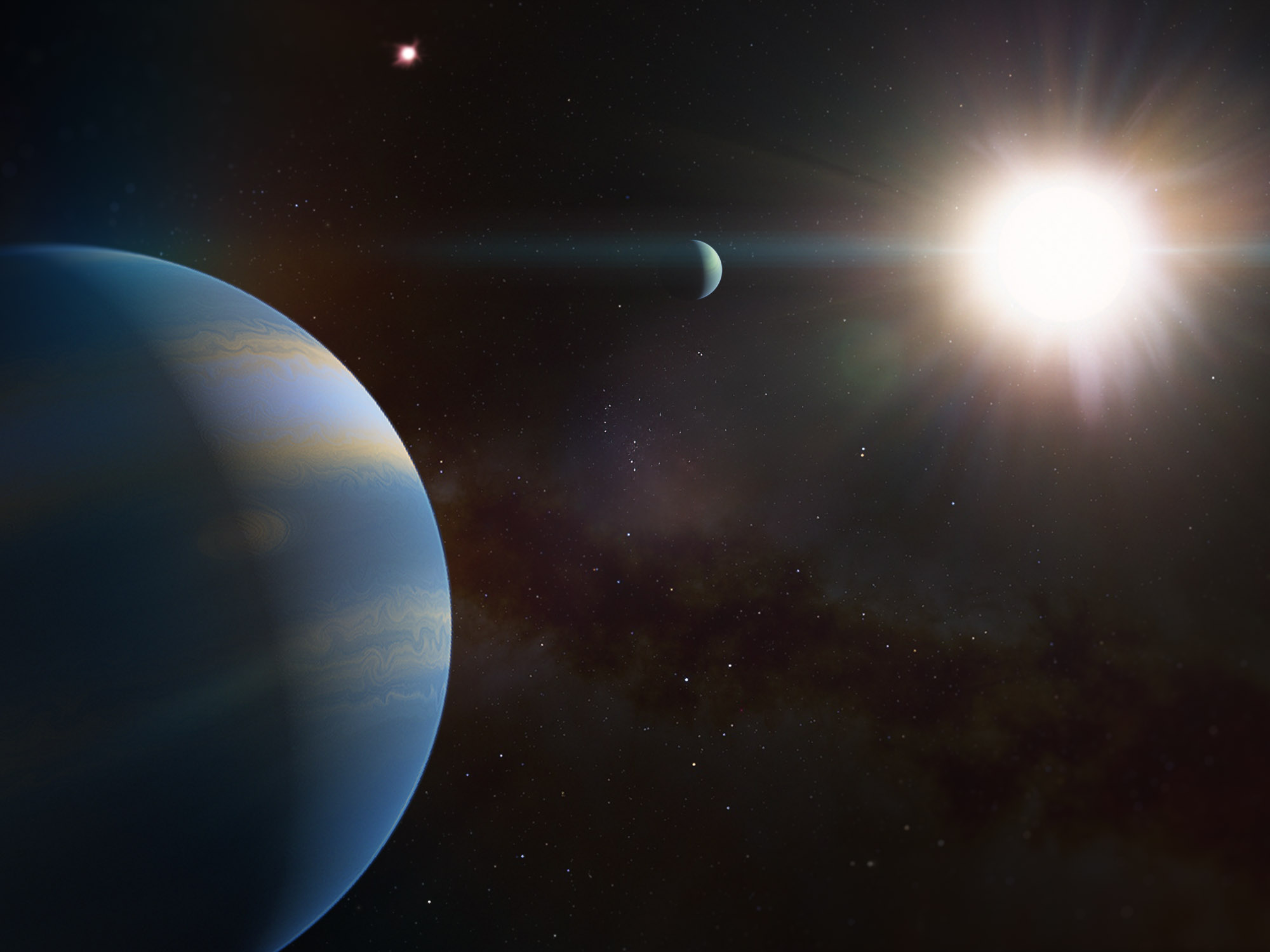TWO PLANETARY SYSTEMS DISCOVERED AROUND STARS SIMILAR TO THE SUN
A study published today in the journal Astronomy & Astrophysics announces the discovery of two new planetary systems orbiting stars similar to our Sun: TOI-1736 and TOI-2141. The study is led by Eder Martioli, researcher at the Laboratório Nacional de Astrofísica, Brazil, and associate researcher at the Institut d'astrophysique de Paris (IAP), and Guillaume Hébrard (CNRS, IAP). The observations were made from space and the Observatoire de Haute-Provence. These new exoplanets are mini-Neptune and super-Jupiter types; they have no equivalent in the Solar System.
The discovery of the first exoplanet in 1995 at the Observatoire de Haute-Provence, for which the astronomers Michel Mayor and Didier Queloz were awarded the Nobel Prize in physics, caused a revolution in our understanding of planetary systems. Today, more than 5,500 exoplanets are known. We now know that the Solar System is not unique and does not contain all possible types of planets.

Figure 1: The top left panel shows the TESS space telescope of NASA. It detected the small drops in stellar light caused by the transits of each planet in front of its star. The background image is a photo of the dome of the Telescope 193 cm at the Observatoire de Haute-Provence, France, on which the SOPHIE instrument is installed. This instrument established that the candidates identified by TESS indeed were planets: TOI-2141b and TOI-1736b. It also detected an additional planet, TOI-1736c, not seen by TESS. SOPHIE was finally able to characterize all these planets by the method of radial velocities, in particular measuring their masses.
Credits: NASA and Eder Martioli.
The results published today focus on the study of two stars very similar to the Sun, each harboring a mini-Neptune and one of them also harboring a super-Jupiter. A mini-Neptune is a planet similar to Neptune but smaller, and larger than the Earth1; a super-Jupiter is a giant planet much more massive than Jupiter2. These results were obtained by combining the observations of several instruments (see figure 1), including Transiting Exoplanet Survey Satellite (TESS) and SOPHIE. TESS is a NASA space telescope that detects exoplanets as they pass right in front of their host stars, observing the implied small drops in stellar light. The SOPHIE spectrograph is installed at the 193-cm telescope of the Observatoire de Haute-Provence, France. Regulated in temperature and pressure, its high stability and high precision allow it to detect exoplanets by the small effects they cause on the movement of their host stars.
The planetary system TOI-2141
The first system of this discovery, TOI-2141, consists of a star located 250 light-years away, almost identical in size and slightly older than our Sun. Its chemical composition also reveals a scarcity of heavy elements compared to the Sun. In astrophysics, any chemical species heavier than helium is called a heavy element. Heavy elements are mostly synthesized by stars; their quantity is also an important factor in the process of planetary formation.
The planet TOI-2141b is only three times the diameter of Earth, so it is a mini-Neptune. 24 times more massive than our planet, it orbits its star every 18.3 days. Due to its proximity to this star (only 13% of the Earth-Sun distance), it is estimated that the temperature of the planet is about 450 degrees. Its density suggests the presence of a rocky core and an atmosphere containing a large amount of water vapor. Our Solar System does not have a planet with such characteristics.

Figure 2: Artist’s view of the planetary system TOI-1736, with representations of the super-Jupiter TOI-1736c (left) and the mini-Neptune TOI-1736b (center).
Credit: Leandro de Almeida.
The planetary system TOI-1736
The second system of this discovery, TOI-1736, is even more exotic (see figure 2). Located 290 light-years away, the star is similar to the Sun. Yet, it is the main component of a binary star, as it is accompanied by a second star, which is smaller and colder. At least two planets have been detected around this main star.
The first one, TOI-1736b, is a new mini-Neptune, with a diameter 2.5 times larger than Earth and a mass 13 times greater. It has a 7.1-day orbit around its star, of which it is very close: only 7% of the Earth-Sun distance. Due to this proximity, the planet receives strong radiation from the star, resulting in an estimated atmospheric temperature of 800 degrees.
The second planet, TOI-1736c, is nine times more massive than Jupiter, the largest planet in the Solar System. Classified as super-Jupiter, it completes an orbit every 570 days around its star. This planet is in the habitable zone of its star. This zone is defined as the region around the star having an appropriate temperature to allow the existence of liquid water on the surface of the planet. Like Jupiter, TOI-1736c is most likely a gas giant planet, so it should not have a solid surface. However, if the planet TOI-1736c were to host a moon, it could have an atmosphere and liquid water on its surface, and perhaps, could constitute a habitable world.
Observations of TOI-1736 revealed indications of a possible third planet orbiting at a greater distance, requiring long-term monitoring for confirmation. The team, and in particular the IAP, therefore continue to observe TOI-1736 with the spectrograph SOPHIE at the Observatoire de Haute-Provence, in the hope of collecting soon more information about this star, which is similar to the Sun but hosting a remarkably different planetary system.
Footnotes
![]() 1. Neptune’s mass is 17 times that of the Earth, and its diameter is almost four times that of the Earth.
1. Neptune’s mass is 17 times that of the Earth, and its diameter is almost four times that of the Earth.
![]() 2. Jupiter has a diameter eleven times larger than that of Earth, and a mass 320 times higher.
2. Jupiter has a diameter eleven times larger than that of Earth, and a mass 320 times higher.
Links
![]() The scientific article published today in the journal Astronomy & Astrophysics by Martioli, Hébrard, de Almeida, Heidari et al. (2023), « TOI-1736 and TOI-2141: two systems including sub-Neptunes around solar analogs revealed by TESS and SOPHIE »
The scientific article published today in the journal Astronomy & Astrophysics by Martioli, Hébrard, de Almeida, Heidari et al. (2023), « TOI-1736 and TOI-2141: two systems including sub-Neptunes around solar analogs revealed by TESS and SOPHIE »
![]() The SOPHIE spectrograph at OHP
The SOPHIE spectrograph at OHP
Writing and contacts
- Eder Martioli
Laboratório Nacional de Astrofísica, Itajubá, Brazil (associate researcher at the IAP)
eder [dot] martioli [at] iap [dot] fr - Guillaume Hébrard
Institut d’astrophysique de Paris, CNRS, Sorbonne Université
guillaume [dot] hebrard [at] iap [dot] fr
Web writing: Valérie de Lapparent
Layout: Jean Mouette
December 2023
